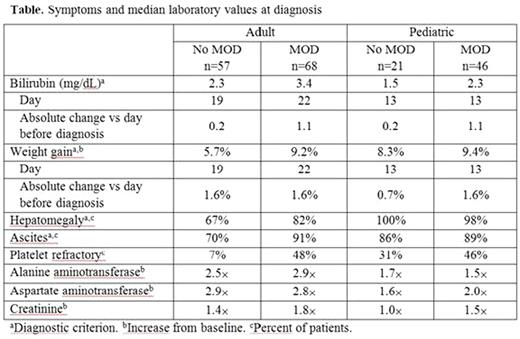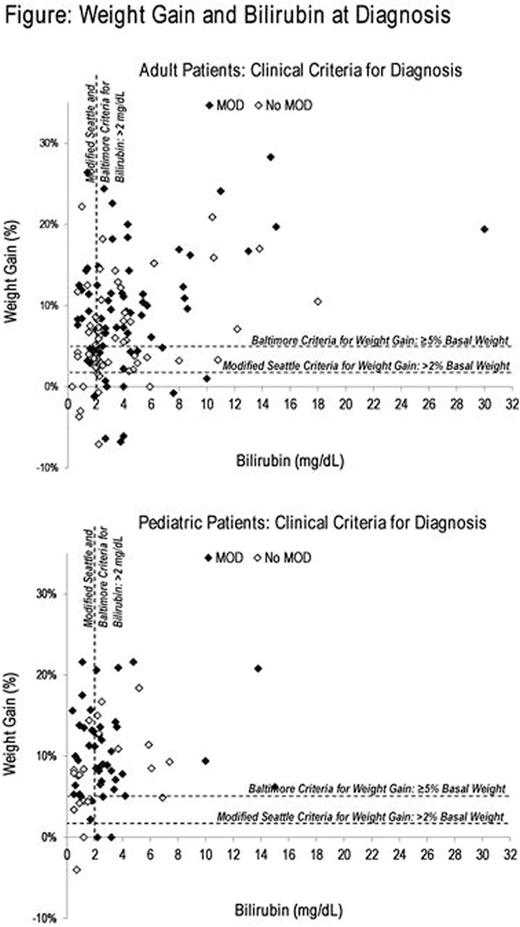Abstract
Background: VOD/SOS, a potentially life-threatening complication of HSCT conditioning, has historically been diagnosed using modified Seattle criteria (≥2 of: bilirubin >2 mg/dL, hepatomegaly, or >2% weight gain [sometimes >5%]) or Baltimore criteria (bilirubin ≥2 mg/dL and ≥2 of: hepatomegaly, ascites, ≥5% weight gain); the European Society for Blood and Marrow Transplantation proposed new adult criteria in 2016. VOD/SOS with multi-organ dysfunction (MOD) may be associated with >80% mortality. This chart review characterizes VOD/SOS diagnosis patterns.
Methods: Physicians performed ≥5 transplants/year in accredited centers listed by the Center for International Blood and Marrow Transplant Research, and provided data from the most recent 1-3 patients with VOD/SOS (with or without MOD) post-HSCT diagnosed in the past 3 years. MOD was defined by renal failure (creatinine clearance 3´ baseline), pulmonary failure (mechanical ventilation, oxygen requirement, or saturation <90%), or heart failure.
Results: 200 charts were identified, most at centers participating in a VOD/SOS drug-treatment protocol. 8 charts had missing data, leaving 192 (125 adults and 67 pediatric patients [≤17 years]). Prespecified VOD/SOS risk factors (most common: ≥2 chemotherapy regimens, Karnofsky score <85, second remission, and hepatic comorbidity) were generally more frequent in adults than pediatric patients. Most adult and pediatric patients were reported to have had myeloablative conditioning (MAC; 74% and 65%, respectively) vs reduced-intensity conditioning/autologous HSCT (RIC; 26% and 35%, respectively). In adults, diagnostic ultrasound was used in 90% and biopsy in 29%, typically on the day of VOD/SOS diagnosis. However, patients were diagnosed with VOD/SOS even though 31% and 19% of the respective tests did not confirm VOD/SOS.
At diagnosis, 48% of adult and 51% of pediatric patients exceeded minimums for both ≥5% weight gain and ≥2 mg/dL bilirubin components of Baltimore criteria; by modified Seattle criteria, 62% of adults and 51% of pediatric patients exceeded >2% weight and >2 mg/dL bilirubin components (Figure). Adults had higher laboratory values at diagnosis, while pediatric patients generally had more clinical symptoms (Table).
MOD was identified in 54% of adult and 69% of pediatric VOD/SOS patients, and these patients generally had greater clinical and laboratory burden than patients without MOD. MOD was more common among patients receiving RIC (65%) than MAC (57%). Bilirubin and weight gain at diagnosis and at peak were higher in patients with vs without MOD (Table). The increase in bilirubin level between the day before diagnosis and day of diagnosis was generally higher in patients with MOD, although rate of weight gain was similar between adult MOD and non-MOD groups.
Conclusion: In this study, many patients' signs at diagnosis had progressed beyond VOD/SOS diagnostic criteria. Overall, adults were diagnosed later in disease progression than pediatric patients. Patients with MOD generally had earlier occurrence and higher, more rapidly rising levels of markers at diagnosis: an observation that may aid early identification of MOD. Interestingly, patients with VOD/SOS who received RIC vs MAC had higher rates of MOD. Together, these findings may help in prompt diagnosis of VOD/SOS, which may improve patient outcomes.
Support: Jazz Pharmaceuticals
Doede:Jazz Pharmaceuticals: Employment, Equity Ownership. Viddam:Jazz Pharmaceuticals: Employment, Equity Ownership. Villa:Jazz Pharmaceuticals: Employment, Equity Ownership. Hannah:Jazz Pharmaceuticals: Consultancy. Weaver:Jazz Pharmaceuticals: Consultancy. Tappe:Jazz Pharmaceuticals, Inc.: Employment, Other: stock options exercisable for, and other stock awards of, ordinary shares of Jazz Pharmaceuticals plc.
Author notes
Asterisk with author names denotes non-ASH members.



This feature is available to Subscribers Only
Sign In or Create an Account Close Modal